Fault Reconstruction for a Giant Satellite Swarm Based on Hybrid Multi-Objective Optimization
Abstract
1. Introduction
2. Construction of On-Orbit Reconstruction Indicators for a Giant Satellite Swarm
2.1. Model Assumptions of Satellite Swarm Failure
- The mission-oriented satellite swarm is composed of individual star satellites that are connected via inter-satellite communication links.
- The number of satellites in the satellite swarm is , each satellite is of the same type, and each satellite is a regular hexagon [28] with a side length of .
- The satellites in the satellite swarm are evenly distributed, and the distance between adjacent satellites is , which is much smaller than the orbital radius , i.e., .
- The satellites are numbered clockwise from the virtual center of the satellite swarm, and the inter-satellite distance correlation matrix is .
2.2. Relative Motion Modeling
2.3. The Introduction of the Reconstruction Indicators
- (1)
- Satellite swarm health state
- (2)
- Total energy consumption of reconstruction
- (3)
- Fuel consumption balance [33]
3. Fault Reconstruction Based on a Hybrid Multi-Objective Genetic Algorithm
3.1. Genetic Coding for Satellite Numbering
3.2. Construction of Hybrid Multi-Objective Functions
4. Simulation and Analysis
4.1. Fault Reconstruction Simulation
4.2. Monte Carlo Simulation Verification
- Set the number of faulty satellites randomly distributed in the range [1, 30], i.e. .
- Randomly select satellites in a satellite swarm with satellites and generate fault type .
- Set the health state indicator of the objective function in Section 3.2 and the rest of the indicators as constraints, solving the optimal reconfiguration strategy.
- Calculate the optimal health state and average health state of the satellite swarm corresponding to the reconstruction strategy.
- Repeat the above steps 300 times.
- For a satellite swarm with 61 satellites, when the number of faulty satellites is in the range [1, 30], the reconstruction decision algorithm restores the satellite swarm health state to 0.95~0.4. The optimal health is very close to the average health, and the difference is within 10−3, which shows that the algorithm has high precision.
- The health state curve is a typical ponytail curve, and nearly 1/3 of the data show that the health state value of the restored satellite swarm is below 0.7; when the health state is less than 0.7, the health state begins to decrease rapidly and fluctuate.
5. Conclusions
Author Contributions
Funding
Institutional Review Board Statement
Informed Consent Statement
Data Availability Statement
Conflicts of Interest
References
- Alvarez, J.; Walls, B. Constellations, clusters, and communication technology: Expanding small satellite access to space. In Proceedings of the 2016 IEEE Aerospace Conference, Big Sky, MT, USA, 5–12 March 2016; IEEE: Piscataway Township, NJ, USA, 2016. [Google Scholar] [CrossRef]
- McDowell, J.C. The Low Earth Orbit Satellite Population and Impacts of the SpaceX Starlink Constellation. Astrophys. J. 2020, 892, L36. [Google Scholar] [CrossRef]
- Dong, F.; Li, X.; Yao, Q.; He, Y.; Wang, J. Topology structure design and performance analysis on distributed satellite cluster networks. In Proceedings of the 2015 4th International Conference on Computer Science and Network Technology (ICCSNT), Harbin, China, 19–20 December 2015; IEEE: Piscataway Township, NJ, USA, 2015; Volume 1. [Google Scholar] [CrossRef]
- Yang, H.; Jiang, B.; Cocquempot, V. Decentralized fault tolerant formation control for a class of tethered space-craft. IFAC-PapersOnLine 2015, 48, 1128–1133. [Google Scholar] [CrossRef]
- Zhang, C.; Wang, J.; Zhang, D.; Shao, X. Fault-tolerant adaptive finite-time attitude synchronization and tracking control for multi-spacecraft formation. Aerosp. Sci. Technol. 2018, 73, 197–209. [Google Scholar] [CrossRef]
- Li, J.; Kumar, K.D. Decentralized Fault-Tolerant Control for Satellite Attitude Synchronization. IEEE Trans. Fuzzy Syst. 2011, 20, 572–586. [Google Scholar] [CrossRef]
- Yang, H.; Jiang, B.; Cocquempot, V.; Chen, M. Spacecraft formation stabilization and fault tolerance: A state-varying switched system approach. Syst. Control Lett. 2013, 62, 715–722. [Google Scholar] [CrossRef]
- Peng, X. Study on Some Key Techniques of Autonomous Health Management for Spacecraft Propulsion System. Ph.D. Thesis, National University of Defense Technology, Changsha, China, 2017. [Google Scholar] [CrossRef]
- Rosenberg, R.S. Stimulation of genetic populations with biochemical properties: I. The model. Math. Biosci. 1970, 7, 223–257. [Google Scholar] [CrossRef]
- Schaffer, J.D. Some Experiments in Machine Learning Using Vector Evaluated Genetic Algorithms. Ph.D. Thesis, Vanderbilt University, Nashville, TN, USA, 1985. [Google Scholar]
- Palacios, V.; Héctor, L. Translation-Based Approaches to Conformant Planning; Universitat Pompeu Fabra: Barcelona, Spain, 2009. [Google Scholar]
- Palacios, H.; Geffner, H. Compiling Uncertainty Away in Conformant Planning Problems with Bounded Width. J. Artif. Intell. Res. 2009, 35, 623–675. [Google Scholar] [CrossRef]
- Palacios, H. Pruning Conformant Plans by Counting Models on Compiled d-DNNF Representations. ICAPS 2005, 5, 141–150. [Google Scholar]
- Deb, K.; Kalyanmoy, D. Multi-objective optimization. In Search Methodologies: Introductory Tutorials in Optimization and Decision Support Techniques; Springer: Boston, MA, USA, 2013; pp. 403–449. [Google Scholar]
- Li, H.; Zhang, Q. Multi-objective Optimization Problems with Complicated Pareto Sets, MOEA/D and NSGA-II. IEEE Trans. Evol. Comput. 2008, 13, 284–302. [Google Scholar] [CrossRef]
- Zhang, Q.; Li, H. MOEA/D: A Multi-objective Evolutionary Algorithm Based on Decomposition. IEEE Trans. Evol. Comput. 2007, 11, 712–731. [Google Scholar] [CrossRef]
- Qi, Y.; Ma, X.; Liu, F.; Jiao, L.; Sun, J.; Wu, J. MOEA/D with Adaptive Weight Adjustment. Evol. Comput. 2014, 22, 231–264. [Google Scholar] [CrossRef] [PubMed]
- Lalwani, S. A comprehensive survey: Applications of multi-objective particle swarm optimization (MOPSO) algorithm. Trans. Comb. 2013, 2, 39–101. [Google Scholar]
- Coello, C.A.C.; Lechuga, M. MOPSO: A proposal for multiple objective particle swarm optimization. In Proceedings of the 2002 Congress on Evolutionary Computation, Honolulu, HI, USA, 12–17 May 2003; Volume 2, pp. 1051–1056. [Google Scholar]
- Borhanazad, H.; Mekhilef, S.; Ganapathy, V.G.; Modiri-Delshad, M.; Mirtaheri, A. Optimization of micro-grid system using MOPSO. Renew. Energy 2014, 71, 295–306. [Google Scholar] [CrossRef]
- Deb, K.; Pratap, A.; Agarwal, S.; Meyarivan, T. A fast and elitist multi-objective genetic algorithm: NSGA-II. IEEE Trans. Evol. Comput. 2002, 6, 182–197. [Google Scholar] [CrossRef]
- Xia, Z.; Ma, L. An Improved NSGA-II algorithm for multi-objective nonlinear optimization. Microelectron. Comput. 2020, 37, 47–53. [Google Scholar]
- Yusoff, Y.; Ngadiman, M.S.; Zain, A.M. Overview of NSGA-II for Optimizing Machining Process Parameters. Procedia Eng. 2011, 15, 3978–3983. [Google Scholar] [CrossRef]
- Xiao, X. Overview on multi-objective optimization problem research. Appl. Res. Comput. 2011, 28, 805–808. [Google Scholar]
- Li, Z. Overview of Constrained Optimization Evolutionary Algorithms. J. Softw. 2017, 28, 1529–1546. [Google Scholar]
- Xu, B. Research and Application of Multi-Objective Optimization Algorithms Base on Differential Evolution. Ph.D. Thesis, East China University of Science and Technology, Shanghai, China, 2013. [Google Scholar]
- Yang, G. Research on Multi-objective Decision-Making Problems and Their Solving Methods. J. Math. Pract. Theory 2012, 24, 108–115. [Google Scholar]
- Underwood, C. Using CubeSat/micro-satellite technology to demonstrate the Autonomous Assembly of a Reconfigurable Space Telescope (AAReST). Acta Astronaut. 2015, 114, 112–122. [Google Scholar] [CrossRef]
- Li, X. Finite Thrust Orbit Interception Optimization Using Hybrid Genetic Algorithm. Comput. Simul. 2010, 27, 20–23. [Google Scholar]
- Ghiasi, H.; Damiano, P.; Larry, L. A non-dominated sorting hybrid algorithm for multi-objective optimization of engineering problems. Eng. Optim. 2011, 43, 39–59. [Google Scholar] [CrossRef]
- Kang, G.; Zhang, H.; Wei, J.; Wu, J.; Zhang, L. Spacecraft Continuous Dynamic Obstacle Avoidance Trajectory Planning with Optimal Energy. J. Astronaut. 2021, 42, 305–313. [Google Scholar]
- Kang, G.; Yuan, X.; Wu, J.; Yang, Z. Mission-Oriented Real-Time Health Assessments of Microsatellite Swarm Orbits. Appl. Sci. 2022, 12, 5605. [Google Scholar] [CrossRef]
- Yoo, S.-M.; Lee, S.; Park, C.; Park, S.-Y. Spacecraft fuel-optimal and balancing maneuvers for a class of formation reconfiguration problems. Adv. Space Res. 2013, 52, 1476–1488. [Google Scholar] [CrossRef]
- Su, B.; Xie, N. Research on safety evaluation of civil aircraft based on the grey clustering model. Grey Syst. Theory Appl. 2018, 8, 110–120. [Google Scholar] [CrossRef]
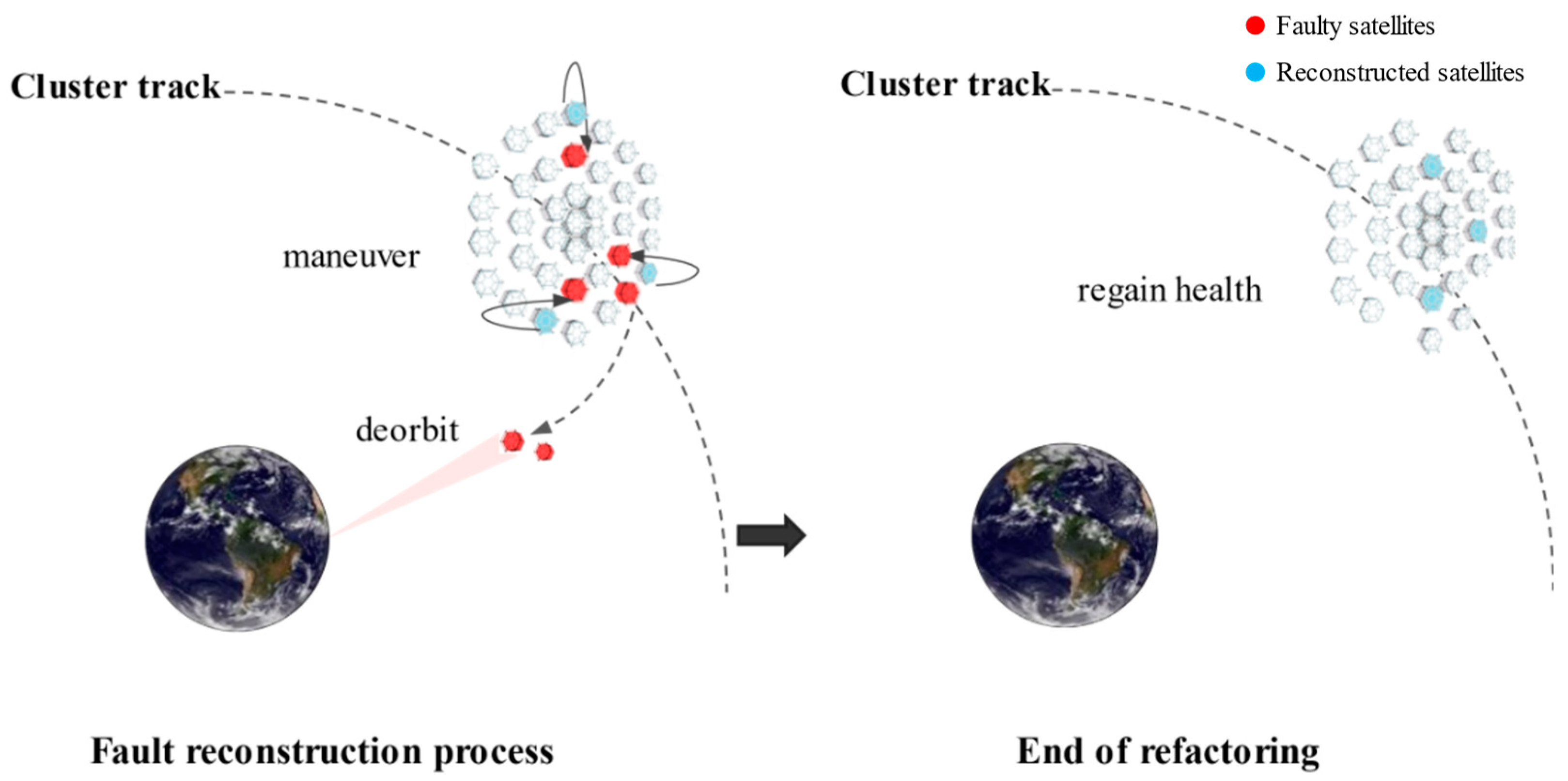

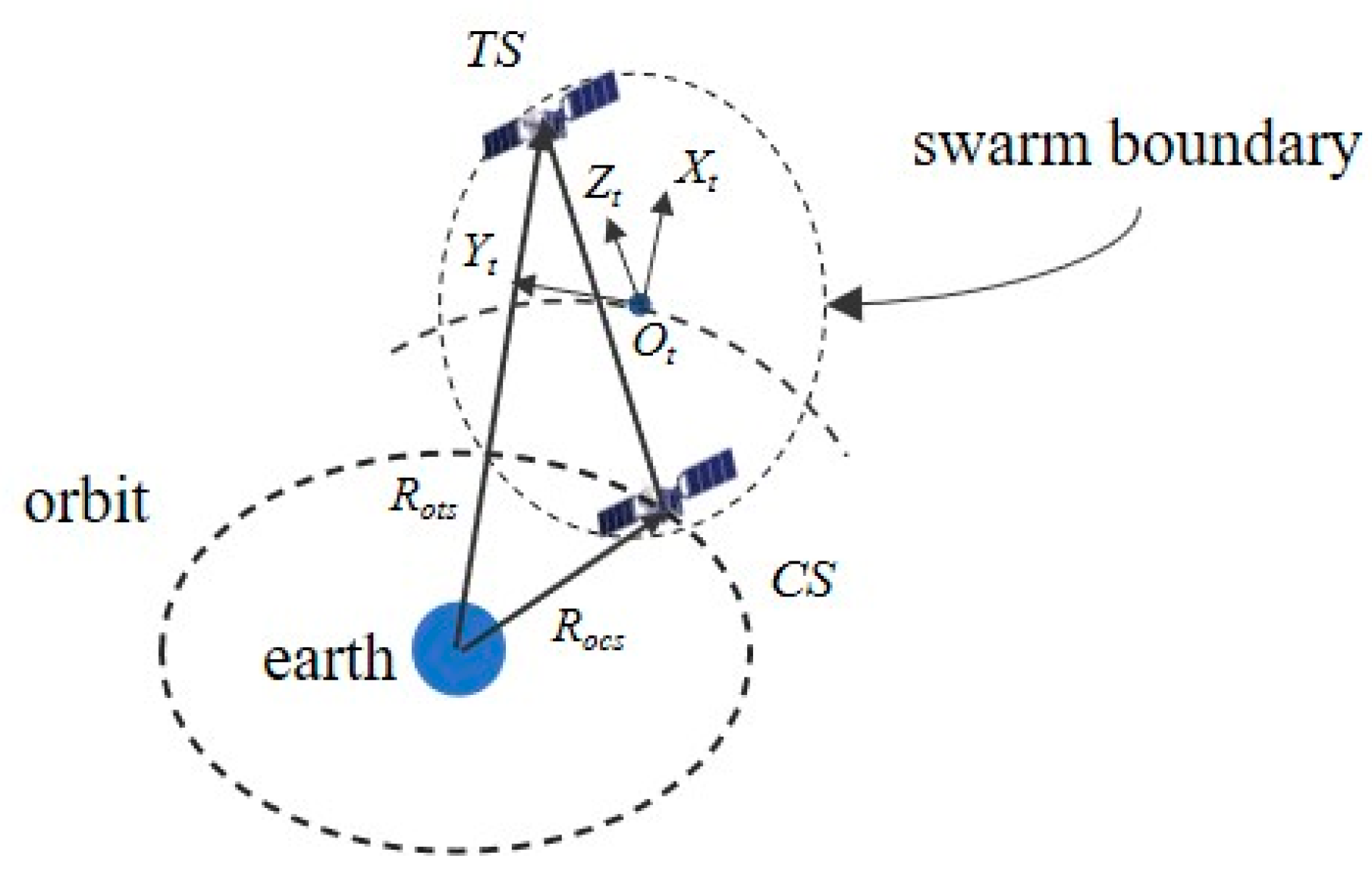


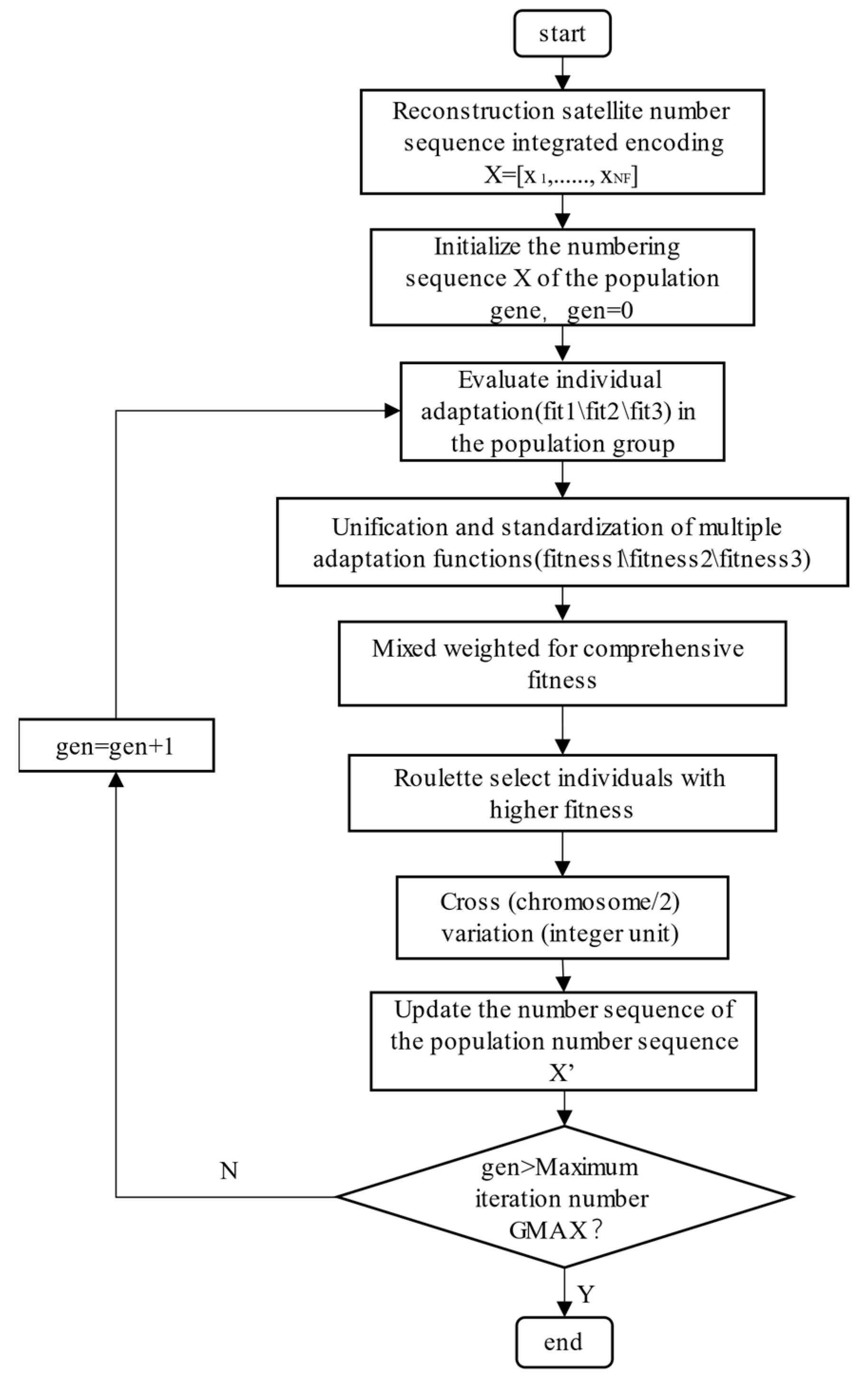
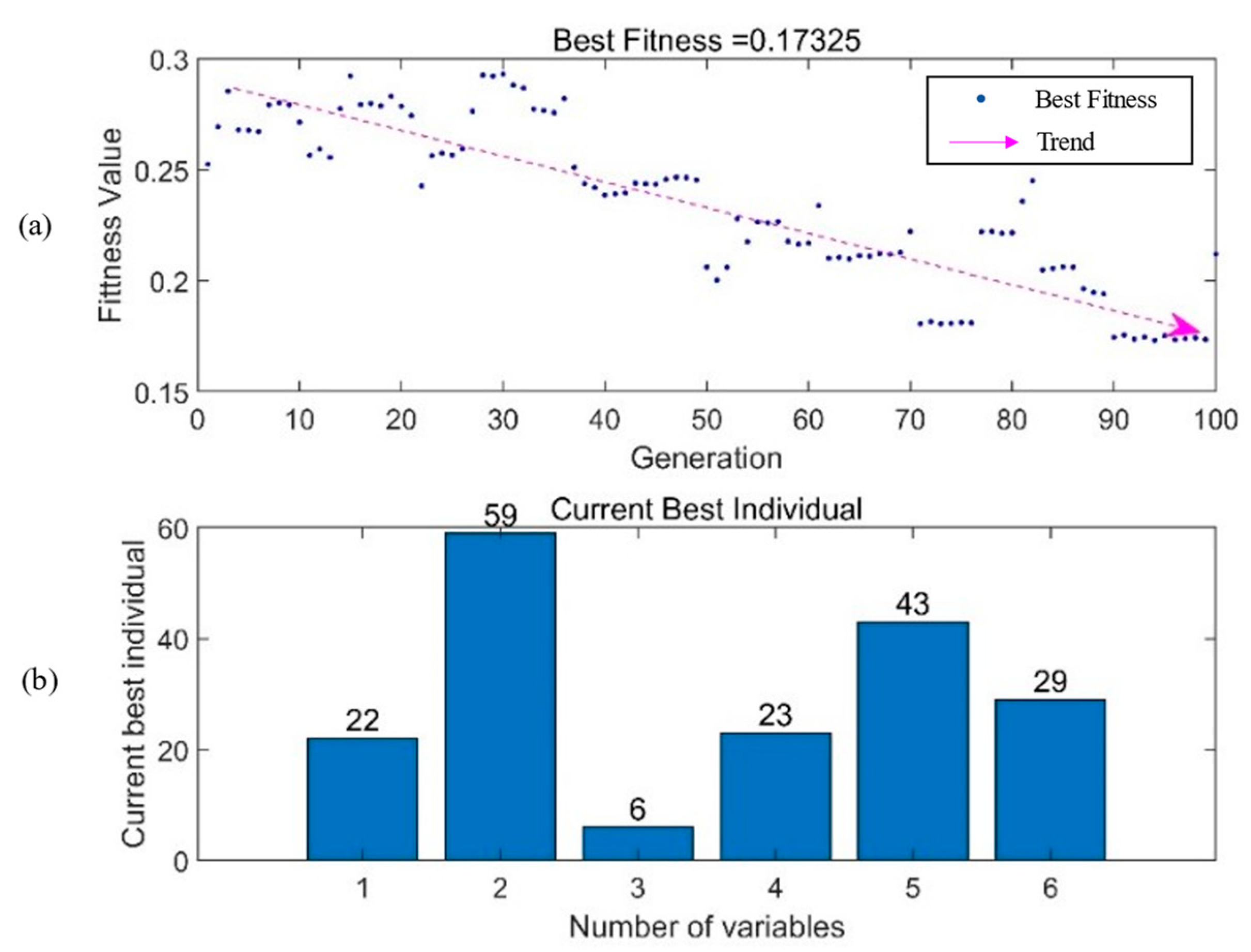
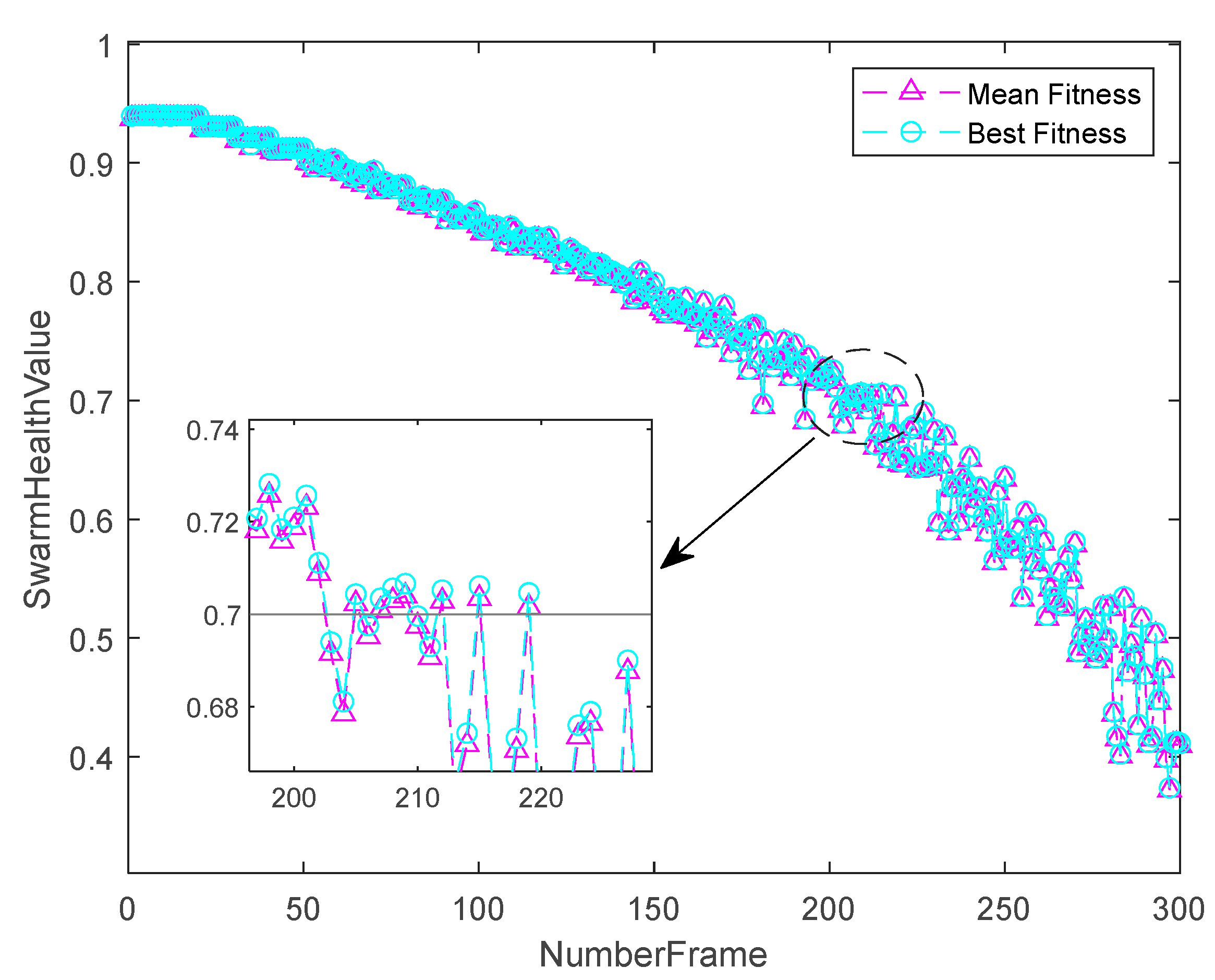
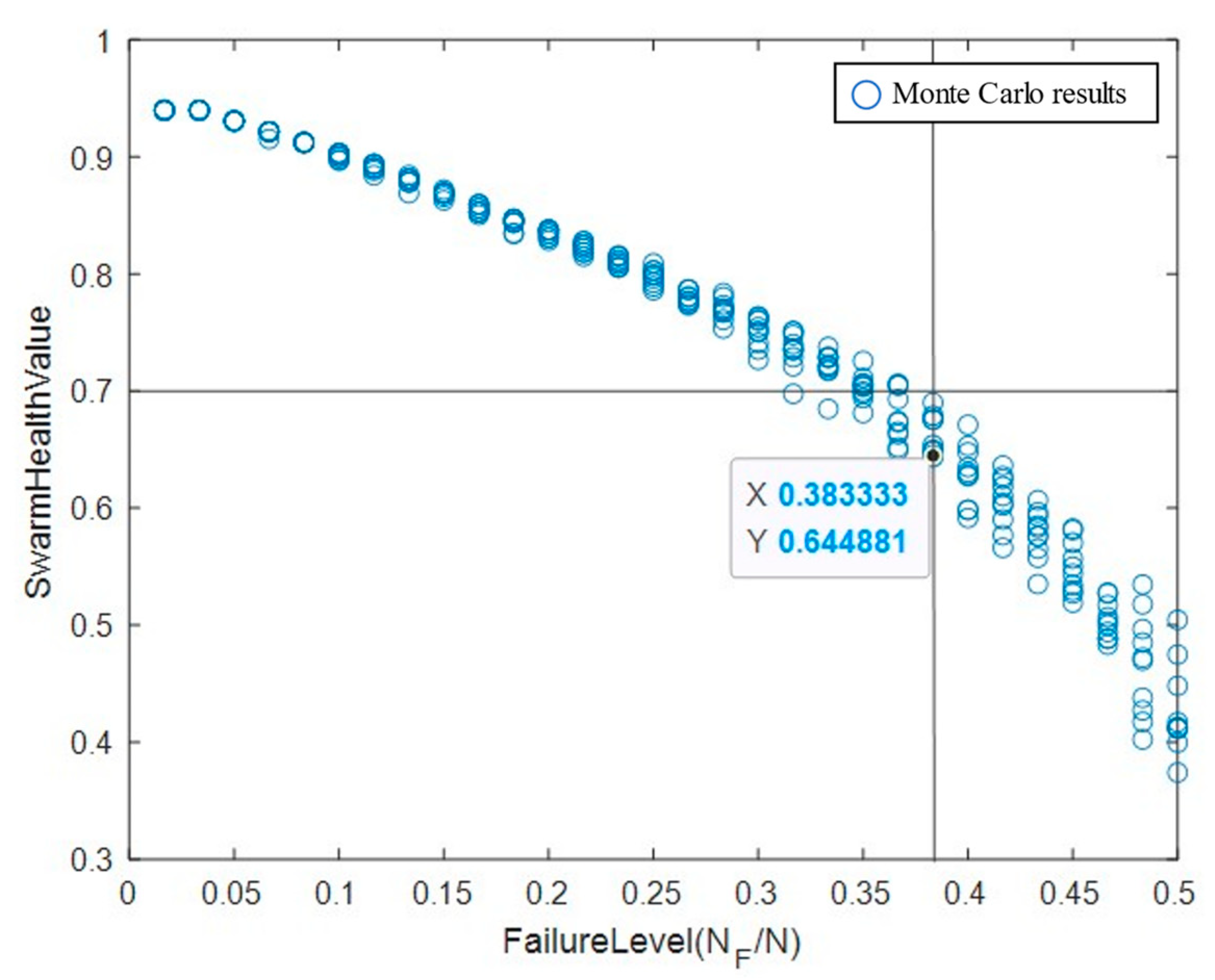
| Parameter | Value |
|---|---|
| 61 | |
| 30 m | |
| [10, 18, 33, 40, 44, 53] | |
| 3.986 × 1014 m3/s2 | |
| 6958 × 103 m | |
| 100 s |
| Module | ||||
|---|---|---|---|---|
| 1 | 0 | 30 | 51.9615 | |
| 2 | 0 | 30 | −51.9615 | |
| 3 | 0 | −15 | −77.9423 | |
| 4 | 0 | 90 | 51.9615 | |
| 5 | 0 | 0 | 103.9230 | |
| 6 | 0 | −75 | −77.9423 |
| Module | SF | ||||||
|---|---|---|---|---|---|---|---|
| 1 | 0 | 0 | 0 | ||||
| 2 | 0 | 0 | 0 | ||||
| 3 | 0 | 0 | 0 | ||||
| 4 | 0 | 0 | 0 | ||||
| 5 | 0 | 0 | 0 | ||||
| 6 | 0 | 0 | 0 |
Disclaimer/Publisher’s Note: The statements, opinions and data contained in all publications are solely those of the individual author(s) and contributor(s) and not of MDPI and/or the editor(s). MDPI and/or the editor(s) disclaim responsibility for any injury to people or property resulting from any ideas, methods, instructions or products referred to in the content. |
© 2023 by the authors. Licensee MDPI, Basel, Switzerland. This article is an open access article distributed under the terms and conditions of the Creative Commons Attribution (CC BY) license (https://creativecommons.org/licenses/by/4.0/).
Share and Cite
Kang, G.; Yang, Z.; Yuan, X.; Wu, J. Fault Reconstruction for a Giant Satellite Swarm Based on Hybrid Multi-Objective Optimization. Appl. Sci. 2023, 13, 6674. https://doi.org/10.3390/app13116674
Kang G, Yang Z, Yuan X, Wu J. Fault Reconstruction for a Giant Satellite Swarm Based on Hybrid Multi-Objective Optimization. Applied Sciences. 2023; 13(11):6674. https://doi.org/10.3390/app13116674
Chicago/Turabian StyleKang, Guohua, Zhenghao Yang, Xinyu Yuan, and Junfeng Wu. 2023. "Fault Reconstruction for a Giant Satellite Swarm Based on Hybrid Multi-Objective Optimization" Applied Sciences 13, no. 11: 6674. https://doi.org/10.3390/app13116674
APA StyleKang, G., Yang, Z., Yuan, X., & Wu, J. (2023). Fault Reconstruction for a Giant Satellite Swarm Based on Hybrid Multi-Objective Optimization. Applied Sciences, 13(11), 6674. https://doi.org/10.3390/app13116674






